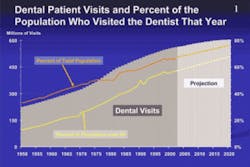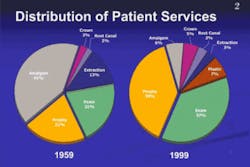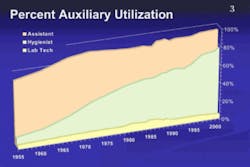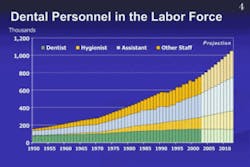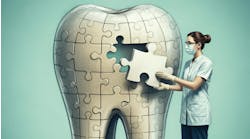Dental practice trends let us explore links between manpower, economics, and the practice of dentistry.
The first three articles in this series explored trends in dental education, how they have impacted dental manpower trends, and dental economic trends. We saw how major shifts in dental school enrollments eventually translated into changes in the number and mix of dentists. The data on dental economic trends document the expansion of the dental service industry during the second half of the 20th century and predicts a continued expansion for the next decade. There are significant trends occurring in the practice of dentistry. This article looks at trends in dental practice and explores the links between manpower, economics, and the practice of dentistry. Finally, we try to anticipate how these trends may affect the practice of dentistry in the future and address issues that may influence the course of dentistry.
Dental practice trends
During the past half-century, Americans established a tradition of visiting the dentist regularly. In 1950, less than one-third of the total population and less than 15 percent of the population aged 64 and older visited their dentists at least once that year, according to the National Health Survey, U.S. Department of Health and Human Services (Figure 1). Today, more than two-thirds of the total population and more than 58 percent of the population 64 and older annually visit their dentists (visitation rates are based on the total population aged 2 and older). A greater awareness of the benefits of regular, monitored, oral health care is probably responsible for the increase in annual patient visits in the overall population, and decreasing levels of edentulism is the likely principal cause for the higher visitation rates among older population groups. Should these trends persist, more than three-fourths of the general population and more than two-thirds of the population 64 and older will have an annual dental visit by the year 2020. About 50 million people (1.6 million people older than 64) had an annual dental visit in 1950. Because of increased visitation rates, population growth, and demographic shifts, an estimated 224 million people (55 million older than 64) will have an annual dental visit in 2020. These trends mirror the increase in the number of patient visits per year which will almost triple from just more than 200 million in 1950 to an estimated 600 million in 2020.
The mix of services provided in the dental office has also changed appreciably during the past 40 years (Figure 2). In 1959, 42 percent of all services in dental offices were examinations and prophys - amalgams accounted for an additional 41 percent of all services. Extractions made up an additional 13 percent of services. So, a typical visit to a dentist in the 1950s was comprised of an examination, cleaning, amalgam, and an occasional extraction. By 1999, this profile of services for general practitioners had changed considerably. Examinations and prophys in 1999 represented 76 percent of all dental services in dental offices. Restorations comprised 13 percent of the procedures and there were more plastic restorations than amalgams. The remaining 11 percent of procedures were comprised of prosthodontic, endodontic, periodontic, and other specialty-type procedures - only 3 percent of all procedures were extractions. If these trends continue during the next 20 years, 86 percent of all procedures in dental offices will be examinations and prophys.
The shift in the types of services provided has prompted a change in mix of personnel involved in the provision of these dental services (Figure 3). Since 1955, there has been an expansion of the number of auxiliary personnel involved in dental offices. In contrast, the percentage of dentists who employ dental laboratory technicians has not changed significantly. The percent of dentists who employ at least one dental assistant has increased from about 70 percent in 1955 to nearly 100 percent in 2000. The most dramatic change has been in the employment of dental hygienists. In 1955, only about 10 percent of dentists employed hygienists. In 2000, some 74 percent of general dentists employed hygienists. This increase in dental hygienists follows the shift toward the provision of preventive services, a higher percentage of the population receiving routine dental care, and a general decline in the caries rate. Since there are more dental hygiene graduates than dental graduates, it is reasonable to envision dental hygienists becoming members of virtually all general-practice offices.
The increased usage of dental auxiliaries has prompted an expansion of the number of dental office personnel. The average staff size of dental offices has increased by about 450 percent during the past half-century. The average number of staff members in dental offices in 1950 was less than one, according to the American Dental Association’s Survey of Dental Practices. Today’s dental offices are far more complex with multiple assistants, dental hygienists, and front desk personnel. There was an average of 4.5 staff members in dental offices in 2000, and the trend for increasing staff size likely will continue.
Another way of looking at this trend is by viewing the total number of dental personnel in the labor force (Figure 4). In 1950, there were approximately 155,000 dental office personnel including dentists, hygienists, assistants, and other staff (secretary/receptionists, office managers, bookkeepers, sterilization assistants, and laboratory technicians) - more than 50 percent of these individuals were dentists. By 2002, the number of dental office personnel had risen to more than 750,000, an almost fivefold increase. Dentists now represent about 20 percent of these individuals. The Bureau of Labor Statistics predicts an increase in the employment of dental hygienists and assistants. By 2012, dental hygienists are predicted to increase from 133,000 to 212,000 (a 59.3 percent increase), and dental assistants are predicted to increase from 224,000 to 379,000 (a 69.2 percent increase). Based upon these projections, there will be more than 1 million people employed in dental offices in 2012, and dentists will represent less than 15 percent of these personnel.
Summary
Through this series of articles we have found the following:
→The number of dental school graduates is unlikely to increase substantially in the foreseeable future, while dental hygiene graduates are likely to increase throughout the next decade.
→The total number of practicing U.S. dentists will probably begin to decline before the end of the decade as the number of retirees exceeds the number of dental school graduates. For the next 15 years, we should see an increase in the proportion of dentists who are specialists, work part time, and are female.
→The dental-service sector experienced tremendous growth during the second half of the 20th century. Except for periods of high inflation, dental incomes generally increased as well. This growth is predicted to continue for the next decade.
→There has been a dramatic shift in the mix of services provided, an increase in the proportion of the population with regular dental visits (especially among the elderly), and an increase in the staffing levels of dental offices during the past 50 years. These trends likely will continue.
Two futures
Three major phenomena collide as we move into the 21st century - a decrease in the supply of dentists relative to the population, an increase in the older population, and an increased recognition that dentistry must serve a larger proportion of the population. Oral health is now more widely recognized as an integral element in overall health.
Accordingly, an increasing proportion of the population seeks oral health care. The most difficult aspect of this issue is providing oral health care to the traditionally underserved segments of our society. Dental offices must continue to improve efficiency if they are to serve an increasing proportion of an expanding population with a dental workforce that is unlikely to expand. There is evidence that supports the notion that dentists are accomplishing that task. During the 1990s, the dentist-to-population ratio generally declined. However, the percentage of the population who had an annual visit to a dentist increased from 57.7 percent in 1989 to 65.6 percent in 2001, according to National Health Interview Surveys compiled by the National Center for Health Statistics.
One of the key issues emerging from these trends concerns the management of the burgeoning dental practice of the future: Do dental school graduates and practicing dentists have the desire and business acumen that will enable them to efficiently manage the increasingly large, complex dental offices of the future?
The medical profession confronted this issue years ago. As the business aspects of running a medical practice became increasingly complex, many physicians decided to concentrate on patient care and left the management of their medical offices to others. Today, about 25 percent of all physicians work for corporate entities. As dental offices become bigger businesses, business will become more interested in dentistry.
Organized dentistry and dental education have an obligation to the profession to provide meaningful educational opportunities that help dentists adjust to a changing practice environment.
Dental education - Despite all indications that dental school graduates will become practicing dentists, dental schools have done a relatively poor job of educating students on the business aspect of running a dental practice. During the past 20 years, half of dental school graduates have rated their educational experiences in practice management as inadequate. This percentage actually increases when graduates who have been in practice for a number of years are surveyed. Teaching a course in practice management has obviously not been an effective solution. In addition to pertinent coursework, business-practice principles must be integrated into clinical programs to provide a constant source of feedback.
Organized dentistry has several issues that need to be addressed. First, organized dentistry must investigate and effectively communicate relevant information on manpower and the changing nature of dental practices. It must continue to provide effective continuing education opportunities for dentists who want to improve their business skills. Finally, it needs to investigate and, when appropriate, make recommendations regarding the scope of practice for dental auxiliaries.
It is in dentists’, the profession’s, and the public’s best interest to maintain the current model of dental care delivery, where dentists are fully involved in ownership, management, and the provision of care. Only then will patients’ needs exceed corporate motives. The future of the current model of dental practice is inexorably tied to the effective deployment of an expanding dental team and the efficient management of an expanding dental practice. The next decade could witness a fundamental change in the character of the current dental practice model. It is incumbent upon all members of the profession to be informed and involved in this process. Only then can we ensure appropriate care for our patients and continued professional status for dentistry and oral health care.
Dr. Eric S. Solomon is executive director for institutional research at The Texas A&M Health Science Center and professor, Public Health Sciences, Baylor College of Dentistry. Prior to joining the Baylor College of Dentistry in 1992, Dr. Solomon served as the assistant executive director for application services and resource studies at the American Dental Education Association. He has published numerous articles and lectured widely on trends in dentistry, dental manpower, and dental education. Dr. Solomon may be reached by e-mail at [email protected].

